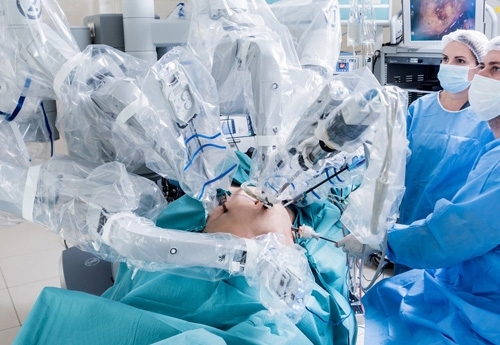Kidney cancer is a malignant tumor that develops from the uncontrolled proliferation of cells in the kidney tissue due to genetic mutations. The most common type is renal cell carcinoma, which originates from the tubular epithelium of the kidney. Papillary, chromophobe, and collecting duct subtypes are less common.
Kidney tumors may be localized to the kidneys in the localized stage, but in advanced stages, they can metastasize to surrounding tissues, lymph nodes, or distant organs.

Kidney cancer is often asymptomatic in the early stages, and most cases are detected incidentally during imaging studies.
However, the following symptoms may occur in later stages:
Robotic kidney cancer surgery is a safe surgical method used to treat kidney cancer, and sometimes it removes kidney tissue when a non-functional kidney needs to be removed.
Robotic kidney cancer surgery is an advanced, minimally invasive surgical technique that uses a robotic surgical system to remove cancerous tissue or the entire kidney. It is generally used to treat kidney tumors, but it is also preferred in cases where a non-functional or severely damaged kidney needs to be removed.
The gold standard treatment for kidney cancer surgery involves either removing the entire kidney (robotic radical nephrectomy) or preserving the normal kidney tissue while removing only the cancerous tissue (robotic partial nephrectomy). The da Vinci robot, with its three-dimensional, high-resolution imaging and superior maneuverability, can achieve better results.
Robotic kidney cancer surgery is a minimally invasive surgical procedure performed without large incisions, particularly for tumors of limited size. It is most commonly performed as a robotic partial nephrectomy. In this procedure, the surgeon removes the cancerous tissue while preserving the surrounding healthy kidney tissue using the high-resolution 3D image provided by the robotic system and flexible robotic arms. During the surgery, the kidney vessels are temporarily closed, and after the tumor is removed, the remaining tissue is repaired using specialized techniques.
The robotic arms are inserted into the abdomen through 4-5 incisions, each 8-12 mm. An average 5-10 cm incision may then be required to remove the necessary tissue. The smaller incisions used to insert the arms are often used for this purpose, reducing the total incision size. This incision is much smaller than open surgery.
The robotic system allows the surgeon to move with great precision, even in hard-to-reach areas, and prevents tremors. This increases the safety of the surgery, reduces blood loss, and shortens recovery time. Studies show that robotic surgery preserves kidney function better than traditional laparoscopy and accelerates postoperative recovery.
This is a surgical procedure in which the entire affected kidney is removed using a da Vinci robot, and sometimes the adrenal gland and lymph nodes are also removed. This method is used especially in the presence of kidney tumors larger than 7 cm.
This is a robotic surgery that removes only the mass, preserving the kidney, especially in Stage 1 kidney cancer (smaller than 7 cm). It is also called kidney-sparing surgery. Stitches are placed in the preserved kidney tissue to control bleeding and prevent urine leakage. This is where Da Vinci surgery offers a significant advantage. The rotational capacity of robotic surgery in the posterior and upper pole of the kidney, or in the area close to the vessels, facilitates both mass removal and suturing. This ultimately contributes to a more successful surgery.
Robotic kidney surgery can vary depending on the size of the mass, the location of the kidney, and previous surgeries. The average surgery time is 2 hours.
The average hospital stay is 1-2 days. The majority of patients return home within 1-2 days.
Patients who undergo this surgery are generally moved to the same day. They resume their daily activities within 2-3 days. They return to work in an average of 10 days and to strenuous physical activity in six weeks. All of this is influenced by the patient's preoperative physical capacity.
Prices for kidney cancer surgery performed with the da Vinci robot can vary depending on the hospital's insurance policies, the patient's insurance status, the patient's physical condition, the difficulty of the surgery, and the surgeon's experience. The average cost of robotic kidney cancer surgeries and kidney removal surgeries in our hospital is around 7000-10000 dollars.
Da Vinci robotic kidney cancer surgery (radical and partial nephrectomy) is performed by Associate Professor Arif Demirbaş at Doruk Nilüfer Hospital in Turkey.
For more information, WhatsApp: +905324850016
- I will definitely recommend this hospital in the future.
- I cannot recommend Dr. Arif Demirbaş enough.
- God continue to bless you in all your good work.
All TestimonialsMeet Alpha from Sierra Leone who just undergone a PCNL and Utereoscopy surgeries at the Doruk hospital in Bursa. I want to start by sending a massive thank you to Dr Arif for exhibiting such a {...}
24.01.2025I cannot recommend Dr. Arif Demirbaş enough. My father had been living with a catheter for over two years due to benign prostatic hyperplasia, which also caused bladder stones and an inguinal h{...}
24.01.2025Thanks to you Dr Arif for your successful kidney stone surgery on my Son Ryan since after we came back from Turkey to date Alhamdulillah Ryan is very ok Alhamdulillah bravo for your Good work. {...}
24.01.2025